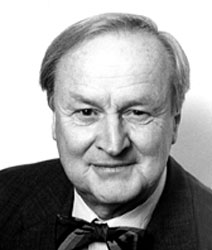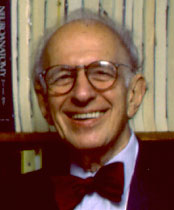|
 Dr. Arvid Carlsson |
This year's Nobel Prize in Medicine has been awarded to three scientists whose work laid the foundation for understanding how drugs affect the brain and recognizing drug addiction as a brain disease. Dr. Paul Greengard, a neurobiologist at The Rockefeller University in New York City and a NIDA-funded researcher, shared the prize with Dr. Eric Kandel of Columbia University in New York City, who recently served on a National Institutes of Health blue-ribbon panel that assessed NIDA's Intramural Research Program, and Dr. Arvid Carlsson of the University of Göteborg, Sweden.
Dr. Greengard received the prize for tracing the biochemical reactions that occur in nerve cells in response to neurotransmitters such as dopamine. This work provided key insights for drug abuse research because drugs of abuse create many of their effects-both pleasurable and dangerous-by altering nerve cells' exposure or reactions to neurotransmitters. For example, methamphetamine and other stimulant drugs increase dopamine exposure, an action which produces feelings of pleasure and, over time, addiction.
 Dr. Paul Greengard |
"Dr. Greengard's work has provided essential insights into the basic brain mechanisms of drug abuse and addiction," says Dr. Jonathan Pollock of NIDA's Division of Neuroscience and Behavioral Research. "With NIDA support, Dr. Greengard currently is continuing this line of research, focusing on how cocaine and amphetamine change neurotransmitter function and the responsiveness of nerve cells to transmitters and drugs. Ultimately, this research may make possible treatment medications to prevent or reverse these drugs' effects."
 Dr. Eric Kandel |
Dr. Kandel was honored by the Nobel committee for demonstrating molecular mechanisms in the brain that are critical for learning and memory. "Dr. Kandel's work may shed light on one of the key problems in understanding addiction," says Dr. Roger Brown, Chief of NIDA's Behavioral Neurobiology Research Branch. "That is to understand how repeated exposure to drugs 'teaches' the brain to become addicted." Dr. Carlsson was cited for demonstrating that dopamine is an important neurotransmitter in brain function, information that paved the way for the work of Dr. Greengard and Dr. Kandel.
The Nobel Prize
The Nobel Prize in Medicine or Physiology is one of five that have been awarded annually since 1901 by the Nobel Foundation in Sweden. The other four are awarded in physics, chemistry, literature, and peace. The prizes were established in the will of Alfred Nobel, a 19th-century intellectual and the inventor of dynamite. A sixth Nobel Prize, in economics, was established in 1968. The Nobel Foundation's full citation for the Physiology or Medicine award, as well as the biographies of the laureates and transcripts of their Noble lectures, can be found on the Web at www.nobel.se.
|